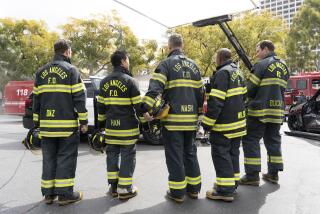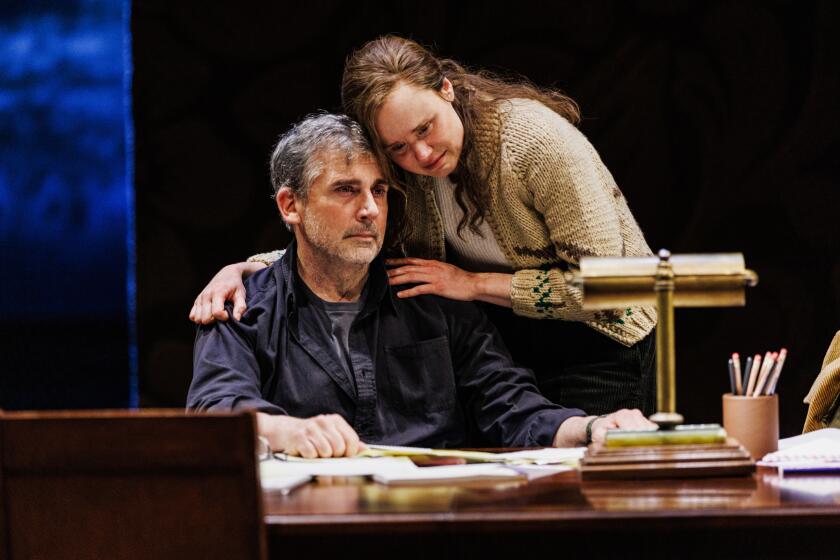The knight of the realm
The other day, as a docent herded a tour group between buildings on the Getty Center’s hilltop campus, an important-looking man swept past: deep tan, bushy mustache, a retinue of photographers and minions in tow. The docent sized up this scene and turned to her visitors.
“I have absolutely no idea who that is,” she announced.
“It was just a delightful moment,” says Barry Munitz, president of the Getty Trust, who apparently possesses excellent hearing along with his tan and mustache. He tells this tale on himself, then releases a burst of laughter into his private conference room, perched above the Getty site.
Munitz, 61, took on the Getty Center not quite five years ago, after two decades in high-profile academic and corporate jobs. Since stepping in, within three weeks of the center’s opening in December 1997, he has reorganized the place, overseen the endowment of more than $4 billion and, he says, applied himself to the Getty’s mission of being many things to many people -- museum, research center, educator and even high-end restaurant.
To this post Munitz brought a big personality and broad reputation. As chancellor of the 330,000-student California State University system from 1991 to 1997, he was known for prodigious energy, broad curiosity and a nearly inexhaustible Rolodex, whose contents were shared in frequent name-dropping. In his office, he kept a gleaming collection of chess sets and books.
Though he took criticism for boosting fees to balance budgets while enrollment fell, Munitz was widely credited for bringing new respect to an academic institution long cast in a role as the state’s second-best.
Yet except for a ripple of fifth-anniversary attention -- hence those photographers the other day -- the wider world hasn’t heard much lately from Barry Munitz. This lull, following his splashy past, has some insiders and outsiders wondering: What exactly does the top dog at the Getty do all day? Has Munitz happily settled into this role, or is this the calm before another transition, perhaps back to the world of higher education?
“We have all the exposure we need,” he answers, citing the museum’s attendance (roughly 25,000 visitors per week) and the trust’s many other programs. His mission on this hilltop, he says, is to make his programs sing and make himself invisible.
“I just wander all around this place saying tell me how this works,” says Munitz. “Explain to me why the digitizing of visual images is such a controversial question. And tell me why you’d be comfortable doing X in the auditorium, but you find doing Y in the auditorium just an absolute outrage. I do go crazy if the learning curve flattens out. But there’s very little danger in these next years of the steepness flattening out.”
Besides, he adds, when he imagines returning to a job dependent on fund-raising, “I just can’t see going back to groveling on a daily basis.”
From an underdog to an elite
BY all the evidence, Munitz’s job is mostly a matter of talk.
He estimates that he handles 20 to 30 incoming phone calls daily (his assistants think it’s more likely twice that).He scorns computers, and rarely uses cell phones, because he doesn’t want to be enslaved by technology, he says. So his staff forwards incoming e-mails via phone and fax, typically forwarding message lists six times a day.
Jill Murphy, the chief of staff he brought with him from the Cal State system, has the task of separating wheat from chaff.
“He doesn’t have hobbies, really. He doesn’t have children. This is what he does, almost obsessively,” says Murphy. In dealings with Getty department heads, she says, “he returns phone calls within 15 minutes. It scared people at first.”
“Nothing piles up,” he says.
Before he dug in at the Getty, Munitz says, he didn’t fully appreciate the depth of difference between speaking for an underdog institution and speaking for an elite one.
Speaking for the underdog, he says, is like acting on stage, with gestures and expressions calculated to reach the back row. And representing the Getty is like acting on screen for a camera that magnifies every nuance.
That difference may help explain the tempest that erupted soon after Munitz took the job. Musing on the trust’s budget, he horrified administrators at other arts institutions by suggesting that the Getty, the wealthiest arts foundation in the U.S., should start looking for donors, instead of just relying on its investments. Munitz defends that idea, and has plans to develop it further, but quieted down when other arts groups howled. Since those first months, Munitz says, he has come to recognize and embrace “the luxury of taking a softer voice for a while.”
He keeps track of Getty-sponsored projects, which reach into more than three dozen countries, and museum workings, which lately include a $50-million offer to buy a Raphael painting from a London collection. He also looks for strategic alliances among cultural groups and philanthropies worldwide.
For Munitz’s predecessor as president, Harold Williams, getting the billion-dollar Getty Center built was the first order of business for more than a decade. First on Munitz’s list of projects is the renovation and reopening of the Getty Villa in Pacific Palisades, a $275-million project now apparently on the brink of resuming after a delay of more than two years amid legal disputes with the property’s residential neighbors. (See accompanying box.)
Another key part of the next five years, he says, will be “ratcheting up” the Getty’s local involvements, such as the 10-year-old program underwriting internships at arts organizations countywide, a three-year series of grants for historic preservation around Los Angeles and grants to pay for organizational planning by smaller organizations from Self-Help Graphics to the Long Beach Museum of Art.
Most of Munitz’s out-of-town work is “showing the flag” and spreading the wealth. When he saw a chance to help the troubled Barnes Foundation in Philadelphia to reorganize and perhaps move its much-admired but seldom-seen collection to a new site, he flew to Pennsylvania, did some groundwork, made two phone calls to board members, then mailed a check for $500,000 to help underwrite an institutional reassessment. He has invested comparable time and money in helping in the reorganization of London’s art history school, the Courtauld Institute of Art, which may allow the loan of some of the Courtauld Gallery’s collection for display at the Getty.
Munitz views it as his job to entertain ideas that a seasoned museum administrator might not. For instance, the Getty has long refused to allow commercial shoots on its site. But last year, when Adidas and Laker star Kobe Bryant asked about using Getty buildings and gardens as a backdrop for some advertising images, Munitz thought again.
“Here we are, so desperately trying to reach out to this range of communities in the city,” Munitz says. “And here’s this extraordinarily visible person ... who loves the Getty.” Under a deal approved by Munitz, Adidas and Bryant got their photo shoot (for no charge, in fact) and the Getty got permission to send that image out as a pro-education poster to hundreds of Los Angeles schools.
For his efforts, Munitz pulled a salary of more than $524,000, plus benefits, last year. But he did not begin on top of a hill.
Raised mostly by a divorced mother in the Flatbush neighborhood of Brooklyn, Munitz went to Brooklyn College because it was free. From there, he earned a PhD in literature at Princeton, taught at UC Berkeley for two years in the late 1960s, and then, just as students and professors across the U.S. were rising up to challenge the nation’s authority figures, he went into academic administration, including stints at the University of Illinois and the University of Houston.
Next he jumped to Houston-based Maxxam Inc., a holding company that has controlled such companies as Pacific Lumber and Kaiser Aluminum. That stint put Munitz close to controversy; apart from weathering protests in California over Maxxam’s redwood lumbering practices, he sat on the board of a Texas savings and loan company that crashed in 1988.
But by 1991, he’d grown wealthy and his business experience made him attractive when Cal State went looking for a new chancellor.
Now, largely but not entirely free of the financial constraints that typically come with nonprofit work, Munitz tells his trustees, “You can do anything you want to do, but you can’t do everything you want to do.” For instance, given the paucity of masterworks in the art market, “there’s not going to be a Vermeer at the Getty. And it has nothing to do with whether we have $2 billion or $4 billion or $15 billion in the endowment.”
Within months of his arrival at the Getty (soon followed by the three dozen chess sets and 1,000 chess books on the shelves of the presidential conference room), he set in motion an overhaul of the organization’s structure -- never mind that the center was designed specifically to fit that structure. He dismantled the trust’s education and information institutes, saying work on those issues should instead be spread throughout the trust’s programs, and recast the Getty Leadership Institute as a museum program instead of a separate department. In late 1998, he found time to serve as head of the transition team for incoming Gov. Gray Davis.
“In some ways he’s a tough egg out of Brooklyn. We had our disputes when I was there,” says Michael Roth, who served as assistant director of the Getty Research Institute under Munitz, then left to become president at the California College of Arts and Crafts in Oakland. “But it’s no accident that he’s a great fan of chess. He’s not thinking of the next move, he’s thinking many moves ahead, and that’s indicative of someone who’s committed to the long term health of the institution.”
Since his arrival, Munitz notes, “10 of the 15 board members who hired me are no longer on the board, six of the seven directors that I inherited are no longer here, and three of the seven programs are gone.” The source of his greatest pride so far, Munitz says, is that “we were able to go through that dramatic change without scandal, without tearing the place apart.”
John Walsh, who retired as director of the Getty Museum in September 2000, cites the way Munitz “radiates energy.” Jack Miles, a senior advisor to Munitz since 1999, hails Munitz’s creation of a “climate of transparency” among senior staff. “He tells everybody everything,” says Miles. Munitz is not, however, the most frequently seen man on campus. One former employee, requesting anonymity, counters that Munitz’s daily doings are a mystery to many within the institution, and theorizes that Munitz’s true professional loves are education and politics, not art.
Influential companions
Certainly, educational and political leaders turn up in the company Munitz keeps -- but then, so does just about anybody who wields power in Southern California.
August found Munitz and his wife, Anne, on a boat off Dubrovnik, Croatia, with a group of friends that included philanthropist Eli Broad and former Mayor Richard Riordan.
In September, he walked from Florence to Siena (and looked in on a Getty project nearby) with a group that included Getty trustee Lloyd Cotsen and former Princeton University President Harold Shapiro. In October, Munitz was in London at the Courtauld Institute. And he passed Thanksgiving on Lizard Island, at Australia’s Great Barrier Reef, where he joined a group including Sherry Lansing, chief executive of Paramount Pictures’ Motion Picture Group and member of the UC Board of Regents.
What did he and Lansing talk about? The presidency of the University of California, for one thing.
UC President Richard Atkinson retires in October 2003, leaving open one of the most coveted positions in all academe. The regents’ search committee includes Davis and Lansing.
In the abstract, the UC job “would be a dream come true,” Munitz says. But he notes that when he recruited many in his current team, “I made a commitment that if they came, I’d stay.” Another factor is that “it just wouldn’t feel right” to take over the state’s No. 1 university system after spending so much energy fighting to get more respect for the No. 2 system.
And then there’s the prospect of groveling for dollars again in Sacramento, in the middle of a major budget crunch.
“I’m not a candidate, and won’t be a candidate,” says Munitz.
And besides, there is the job at hand.
“When Harold [Williams] left,” recalls Munitz, “he said to me, ‘I’m giving you an institution that has achieved adolescence. You’re gonna have to bring it to maturity.’ And I think of that all the time.”
More to Read
The biggest entertainment stories
Get our big stories about Hollywood, film, television, music, arts, culture and more right in your inbox as soon as they publish.
You may occasionally receive promotional content from the Los Angeles Times.







